Tennis takes way more than just swinging a racquet. You need strength, speed, endurance, and agility if you want to play your best. This tennis fitness training guide will help you master these essential skills. In this tennis fitness training guide, we’ll explore different techniques for improving your game. This comprehensive tennis fitness training guide will provide insights on how to develop a well-rounded fitness program.
A real tennis fitness program blends power training, injury prevention, smart nutrition, and recovery. It can change your game, no matter how old you are or what level you play.
This tennis fitness training guide emphasizes the importance of blending power training with proper conditioning.
For optimal results, follow the guidelines in this tennis fitness training guide to integrate strength and conditioning tailored to your specific needs.
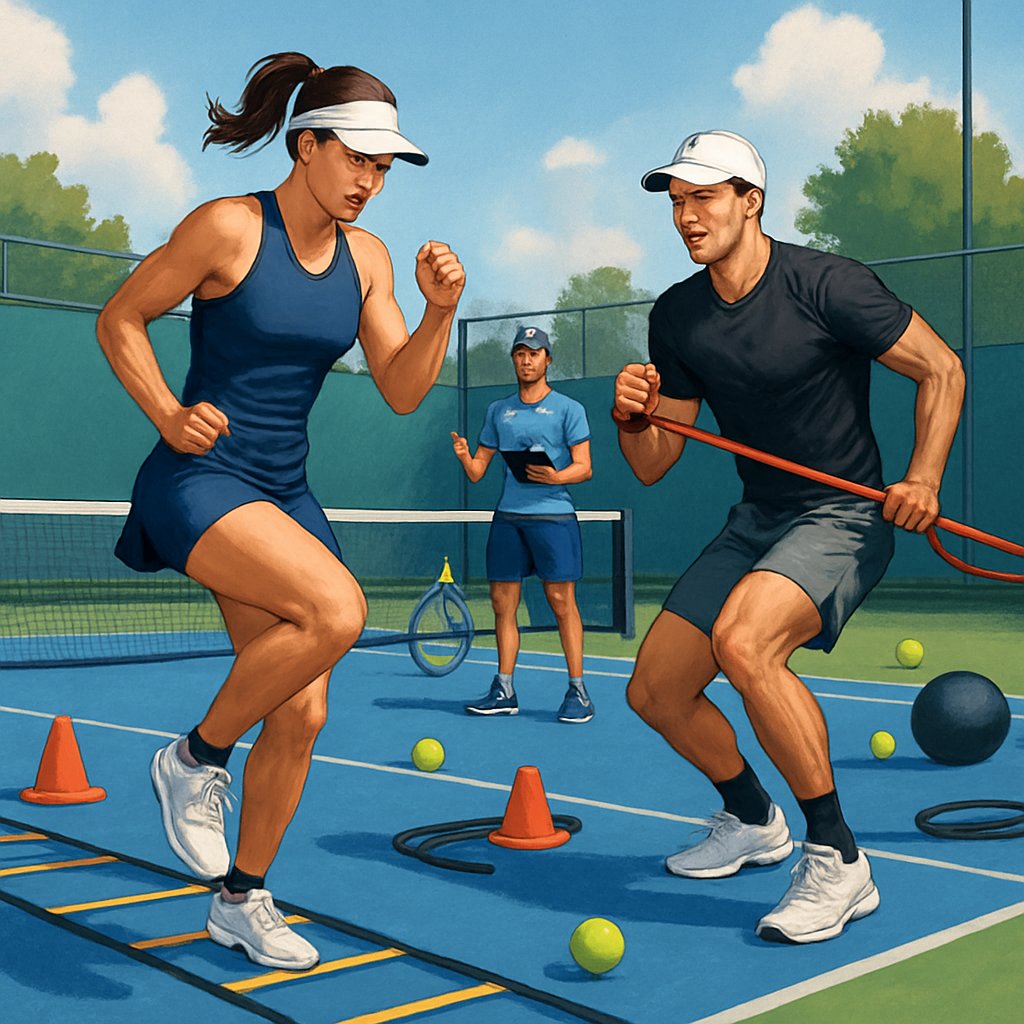
Most players obsess over technique but skip the physical work that makes great shots possible. Tennis demands strength, power, speed, coordination, agility, flexibility, and endurance.
If you skip conditioning, your progress will stall. Technique can only take you so far.
This guide lays out how to build a tennis-specific fitness routine. You’ll pick up ways to serve harder, move faster, avoid injuries, and stay sharp through long matches.
This tennis fitness training guide contains vital information to enhance your training routine, helping you stay competitive.
In this comprehensive tennis fitness training guide, you’ll learn how proper conditioning can elevate your performance on the court.
Stay fit on the court by utilizing the techniques outlined in this tennis fitness training guide, ensuring you maintain peak performance.
This comprehensive tennis fitness training guide lays out how to build a tennis-specific fitness routine.
This tennis fitness training guide is designed to cater to players of all ages, ensuring that you can improve your skills effectively.
Whether you are a beginner or an experienced player, this tennis fitness training guide offers insights that can propel your game to another level.
Doesn’t matter if you’re 15 or 50—these training methods can help you play better tennis.
Key Takeaways
-
- Tennis fitness means mixing strength, agility, endurance, and injury prevention exercises
- Nutrition, recovery, and age-appropriate training keep you at your best on court
- Mental toughness grows with consistent physical prep that makes you trust your body under pressure
Utilizing this tennis fitness training guide will ensure you focus on the right exercises for your specific needs.
Applying strategies from this tennis fitness training guide will lead to better health and improved gameplay.
Serve Harder at Any Age: Power Training for Tennis Players
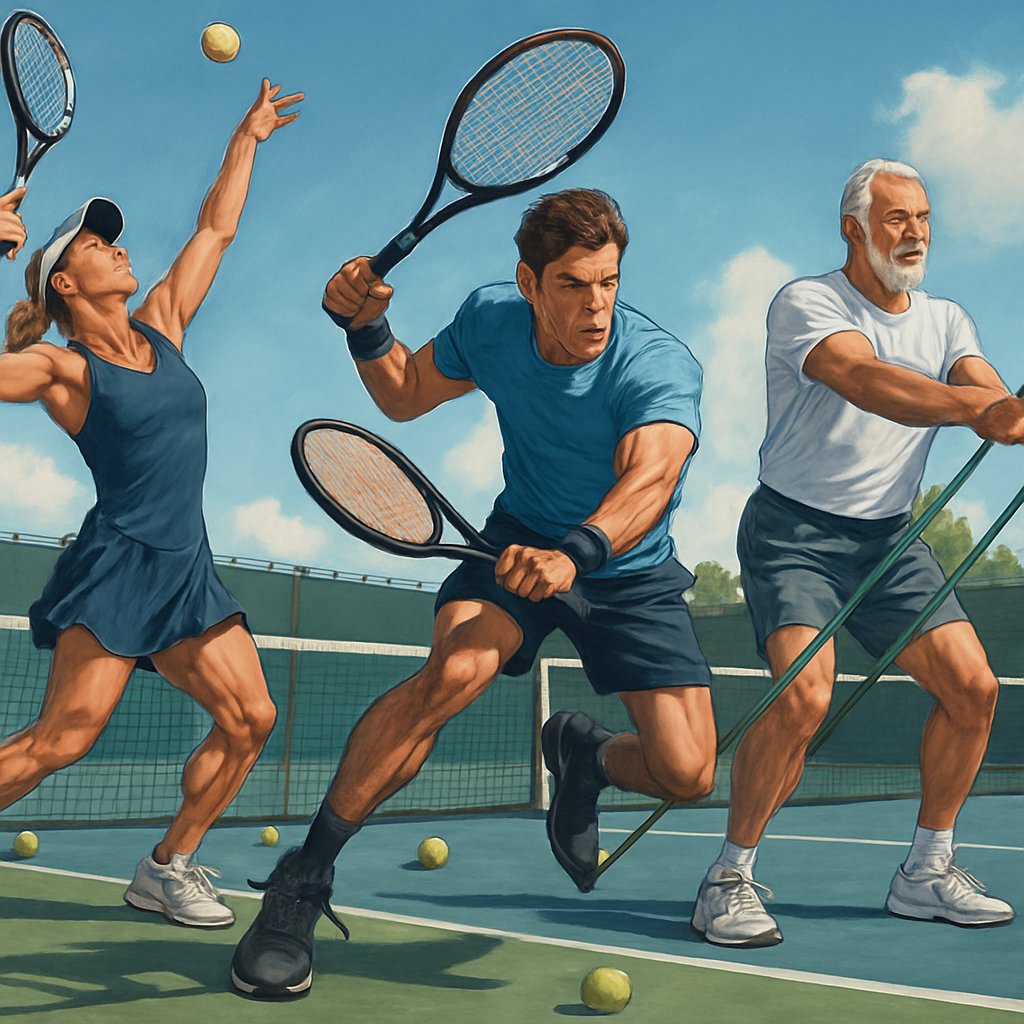
Your serve doesn’t have to lose pop as you get older. The right training can boost your serve power, whether you’re new to fitness or a court veteran.
Power comes from your whole body, not just your arm. Legs, core, and shoulders all pitch in to create that explosive force.
Essential Power Training Elements
Lower Body Power
This tennis fitness training guide outlines essential power training elements that will benefit your overall game.
- Jump squats and plyometrics
- Single-leg hops for balance
- Medicine ball slams
Core Strength
- Weighted Russian twists
- Plank variations
- Rotational moves
Upper Body Explosiveness
- Kettlebell clean and push presses for overhead power
- Resistance band drills
- Pull-ups and push-ups
Top players train for complete conditioning that hits all major muscle groups. That way, you get more power on both your serve and your forehand.
In our tennis fitness training guide, we emphasize the importance of complete conditioning for tennis players.
Utilizing the comprehensive strategies in this tennis fitness training guide can significantly boost your on-court performance.
Age-Specific Training Tips
Players 30-45: Keep your flexibility up as you build strength. Toss in some yoga or stretching between power sessions.
Players 45+: Go easy on the joints—try resistance bands and lighter weights, but do more reps.
All Ages: Workouts should include explosive moves that mimic your serve motion.
Training Frequency
This tennis fitness training guide provides insights on frequency and intensity tailored to your age group.
| Age Group | Sessions Per Week | Focus |
|---|---|---|
| Under 30 | 3-4 sessions | High intensity |
| 30-45 | 2-3 sessions | Balanced approach |
| 45+ | 2-3 sessions | Recovery emphasis |
Start light and keep sessions short at first. Ramp up the intensity as your body gets used to the workload.
Don’t skip recovery—especially as you get older. Take rest days between tough workouts to avoid injuries and see real gains.
Court Speed and Agility: Training for Quick Direction Changes
Proper agility training is emphasized in this tennis fitness training guide, helping you respond quickly on the court.
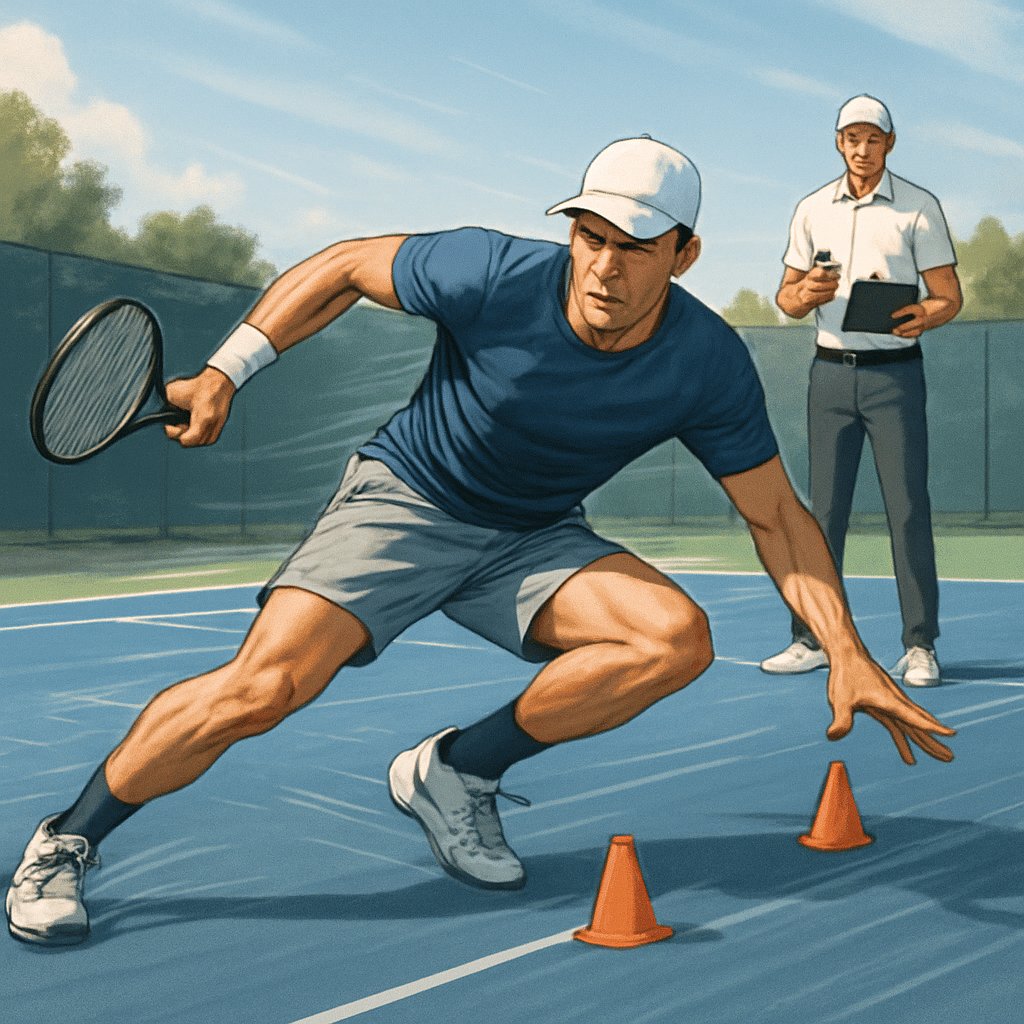
Tennis is all about moving—fast. You need to accelerate, stop, and change direction in a flash to reach every shot.
Agility sets great players apart. Guys like Djokovic and Nadal can sprint 40 feet in one go during matches. That’s wild.
Essential Movement Skills
Focus your training on three main things:
- First-step acceleration – Get off the mark quickly
- Deceleration control – Stop fast without losing your balance
- Multi-directional changes – Move forward, back, and sideways smoothly
Consistent agility drills can speed up your reactions by as much as 15%.
Training Methods That Work
This tennis fitness training guide includes effective training methods that will improve your speed and agility.
Ladder drills help you build quick feet and coordination. Mix in two-foot steps, side shuffles, and crossovers.
Cone drills force you to change direction under control. Set up squares, triangles, and zigzags—just like real court moves.
Shadow swings blend footwork with stroke practice. Move to different spots and swing as if you’re playing a point.
Incorporating drills from this tennis fitness training guide into your routine can enhance your agility and speed.
Agility drills should challenge both your movement and your decision-making.
Building Speed Progressively
Start slow. Nail the form first—don’t rush.
Once you’ve got it, pick up the pace. Throw in visual or sound cues to mimic match pressure.
Hit these drills 3-4 times a week. In about a month, you’ll notice you’re covering the court way better during matches.
Tennis Endurance: Stay Strong Through Three-Set Matches
The tennis fitness training guide also focuses on endurance, crucial for maintaining performance in longer matches.
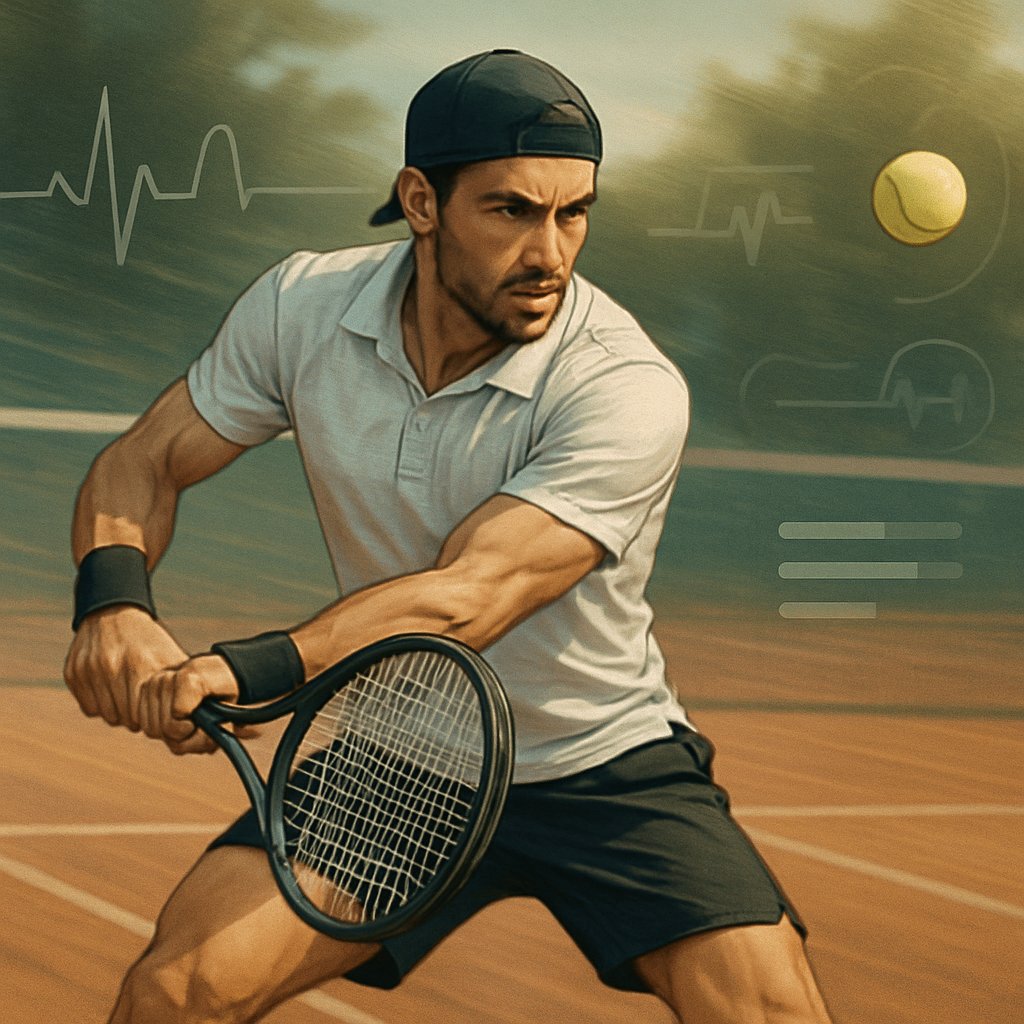
This tennis fitness training guide emphasizes the role of nutrition in recovery and performance, ensuring you are fully prepared for your next match.
Tennis conditioning needs a plan if you want to last through long matches. You have to train both your heart and your muscles to handle the grind.
Endurance training isn’t just about running. Aerobic training gives you the stamina to stay sharp from start to finish.
Key Training Methods:
- Interval running – Matches real game intensity
- Circuit training – Builds strength and stamina together
- Tennis-specific drills – Get your body used to real play patterns
Your tennis fitness plan should hit both cardio and strength. Mix up cardio with strength work for lasting stamina and power.
Consult this tennis fitness training guide for a comprehensive look at how to balance cardio and strength.
Essential Training Components:
Explore the essential training components highlighted in this tennis fitness training guide to elevate your overall game.
| Training Type | Purpose | Examples |
|---|---|---|
| Cardio Base | Sustained energy | Long runs, cycling |
| Strength Circuits | Fatigue resistance | Core, legs, shoulders |
| Recovery Work | Injury prevention | Stretching, mobility |
Long runs build your aerobic base and help you recover faster between points.
Strength-endurance circuits should target your legs and core. Those muscles take the most punishment in long matches.
Utilizing the insights from this tennis fitness training guide can help you improve your muscle resilience.
Train like you play. Practice your technique when you’re tired, and do some explosive moves after you’ve already worked up a sweat.
Tennis matches can drag on for hours. Fatigue makes mistakes way more likely—prepare smart so you can avoid those slip-ups.
Consistency beats all-out intensity. Stick with regular training and your endurance will actually last.
Explosive Movement Training: First Step Quickness
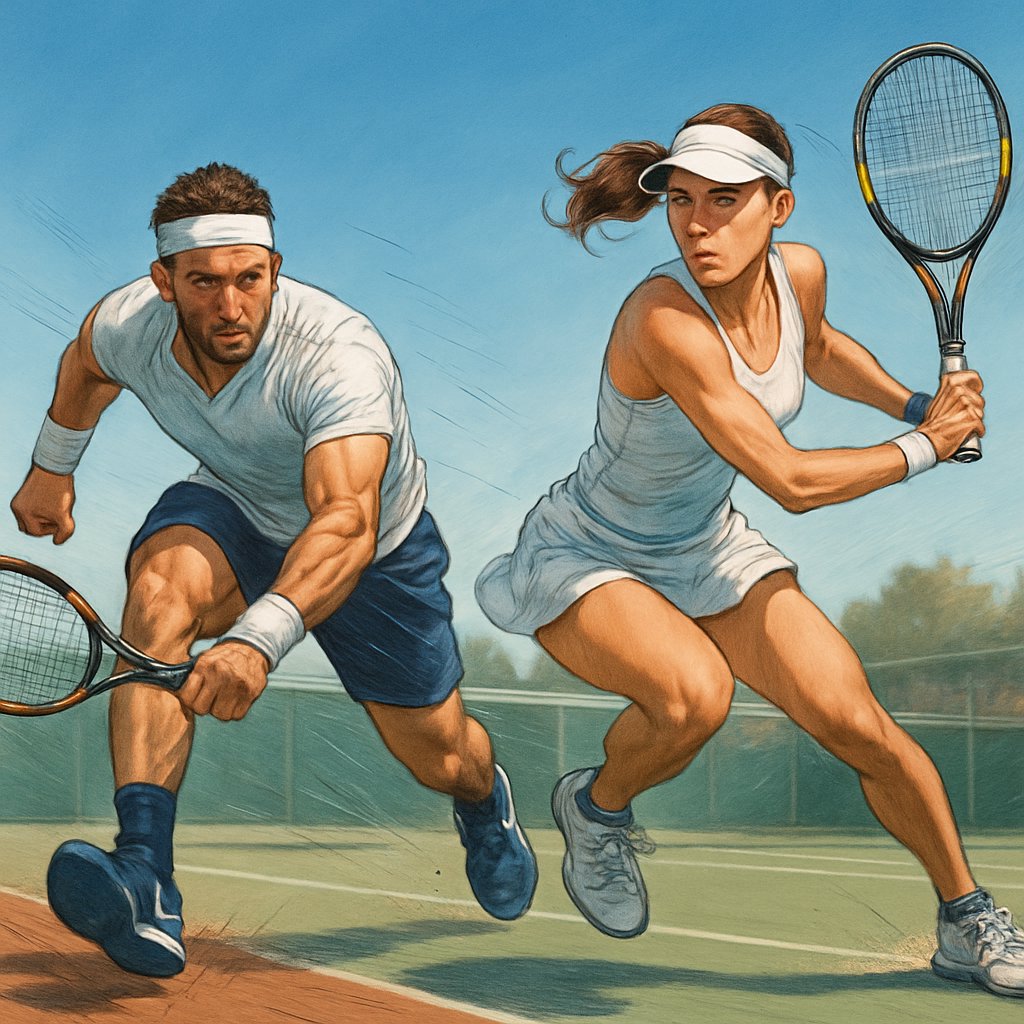
Your first step can decide if you get to the ball or just watch it fly by. Explosive first-step speed takes focused work on reaction time, muscle activation, and power.
Following the recommendations in this tennis fitness training guide will prepare you for the explosive movements necessary in tennis.
Reaction Time Drills
Use visual and sound cues to sharpen your responses. Have someone call out directions and sprint to those spots, or react to quick ball drops.
Power Development Exercises
Build strength for explosive moves:
- Squats and lunges – Leg power
- Single-leg hops – One-leg strength
- Jump squats – Pure explosiveness
- Calf raises – Push-off muscles
Plyometric Training
Plyometrics give you that springy power. Try box jumps, lateral bounds, and depth jumps to get your muscles firing fast.
Court-Specific Movement Patterns
Drill explosive footwork that matches real tennis. Sprint to the net, shuffle along the baseline, and cut diagonally to the corners.
Training Frequency
Hit explosive movement training 2-3 times a week. Keep the focus on quality—go hard, then rest up between reps so you can give max effort every time.
Focus on recovery with tips from this tennis fitness training guide to optimize your performance post-match.
Common Movement Fixes
Stay on the balls of your feet if you want to react fast. Keep a little forward lean to help you move ahead quickly. Don’t forget about your arms—swing them for extra balance and speed when you change direction.
When you move explosively, you cover more court and recover faster for the next shot. Stick with it and you’ll notice way more chances to attack during matches.
Beat Tennis Elbow Before It Beats You: Prevention Guide
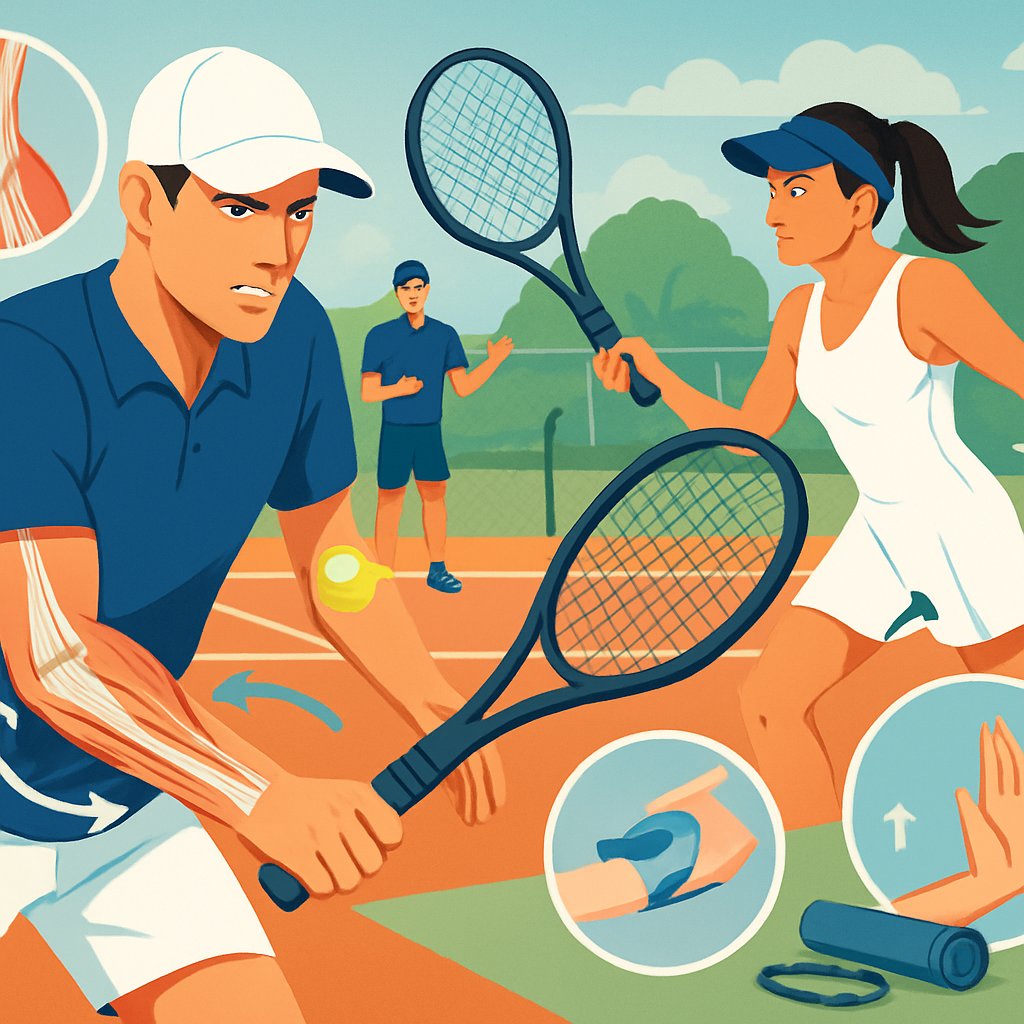
Tennis elbow hits the outer elbow and forearm muscles. You get it from overusing these muscles during tennis or other repetitive activities.
Prevention starts with proper technique. Use a grip size and swing form that feels right for you.
Incorporate the strategies from this tennis fitness training guide to enhance your technique and prevent injuries.
Your racket should fit comfortably in your hand. Don’t squeeze it too tightly.
Always warm up before matches or practice. Light arm circles and gentle stretches wake up those muscles.
Essential Prevention Strategies
| Area | Action |
|---|---|
| Equipment | Use proper grip size |
| Technique | Learn correct swing form |
| Recovery | Rest between sessions |
| Strength | Build forearm muscles |
Strengthen your forearm muscles regularly. Try these eight exercises for easing tennis elbow to build up both flexor and extensor muscles.
For optimal performance, integrate exercises from this tennis fitness training guide into your routine to strengthen your forearm muscles.
Take breaks during long practice sessions. Your muscles need time to recover.
Mix up your training routine. Don’t just stick to tennis every day—throw in some other exercises to balance things out.
Use ice after playing if you notice soreness. Apply it for 15-20 minutes to help with inflammation.
Listen to your body’s warning signs. If your elbow feels painful or stiff, take a break. Pushing through pain usually backfires.
Change your grip pressure during play. Holding the racket too tightly just adds stress to your forearm.
Cross-training helps prevent overuse injuries. Swimming, cycling, or running gives your arms a breather while keeping you active.
Sleep and nutrition matter for muscle recovery. Get enough rest and eat protein to help your body repair itself.
Bulletproof Your Shoulders: Injury Prevention for Tennis Players
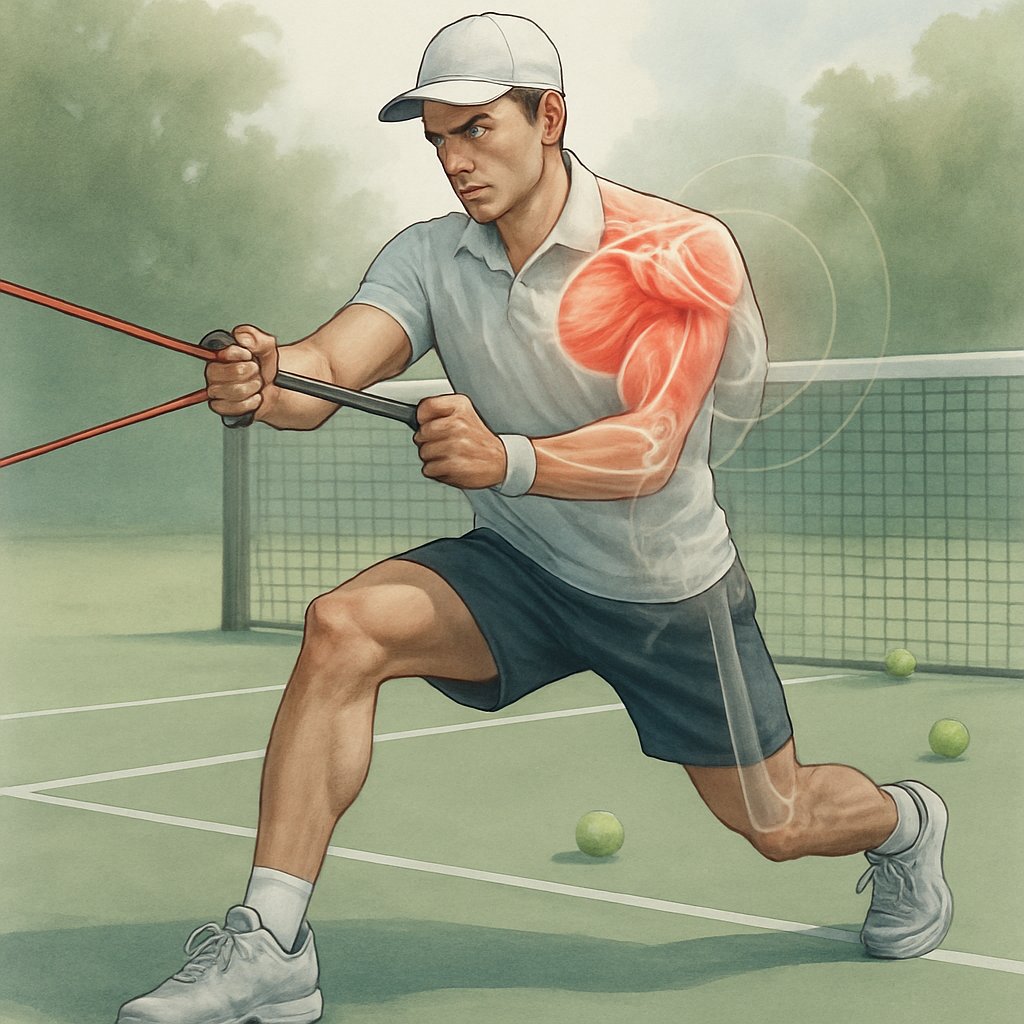
Tennis puts a lot of stress on your shoulders. Every serve, overhead smash, and forehand sends force right through the joint.
The shoulder has the greatest range of motion of any major joint. That flexibility makes it vulnerable, especially in overhead sports like tennis.
Most shoulder problems in tennis come from overuse. Weak muscles and poor technique can throw things off and cause pain.
Prevent injuries by following the guidelines set forth in this tennis fitness training guide, which focuses on proper techniques.
Essential Shoulder Protection Strategies
Dynamic Warm-Up
Start every session with 10 minutes of dynamic movements made for racket sports. Get those shoulders ready before you hit hard.
Rotator Cuff Strength
Your rotator cuff muscles keep your shoulder stable during every swing. A strong rotator cuff is crucial for tennis performance and injury prevention.
Key Prevention Exercises:
- External rotations with resistance bands
- Scapular wall slides
- Prone Y-T-W raises
- Internal rotation strengthening
Range of Motion Maintenance
Losing range of motion limits your game and can cause issues. Stretch your shoulders every day, especially the back (posterior capsule).
Professional Guidance
Good coaching and a formal stretching and strengthening program really matter. Work with trainers who know tennis movements inside out.
Recovery Focus
Schedule rest days in your training. Your shoulders need breaks to keep up with tennis’s repetitive demands.
Regular shoulder maintenance helps you avoid that drooped “tennis shoulder” look. Take care of those joints—they’ll thank you later.
Knee Pain on the Court: Strength Training Solutions
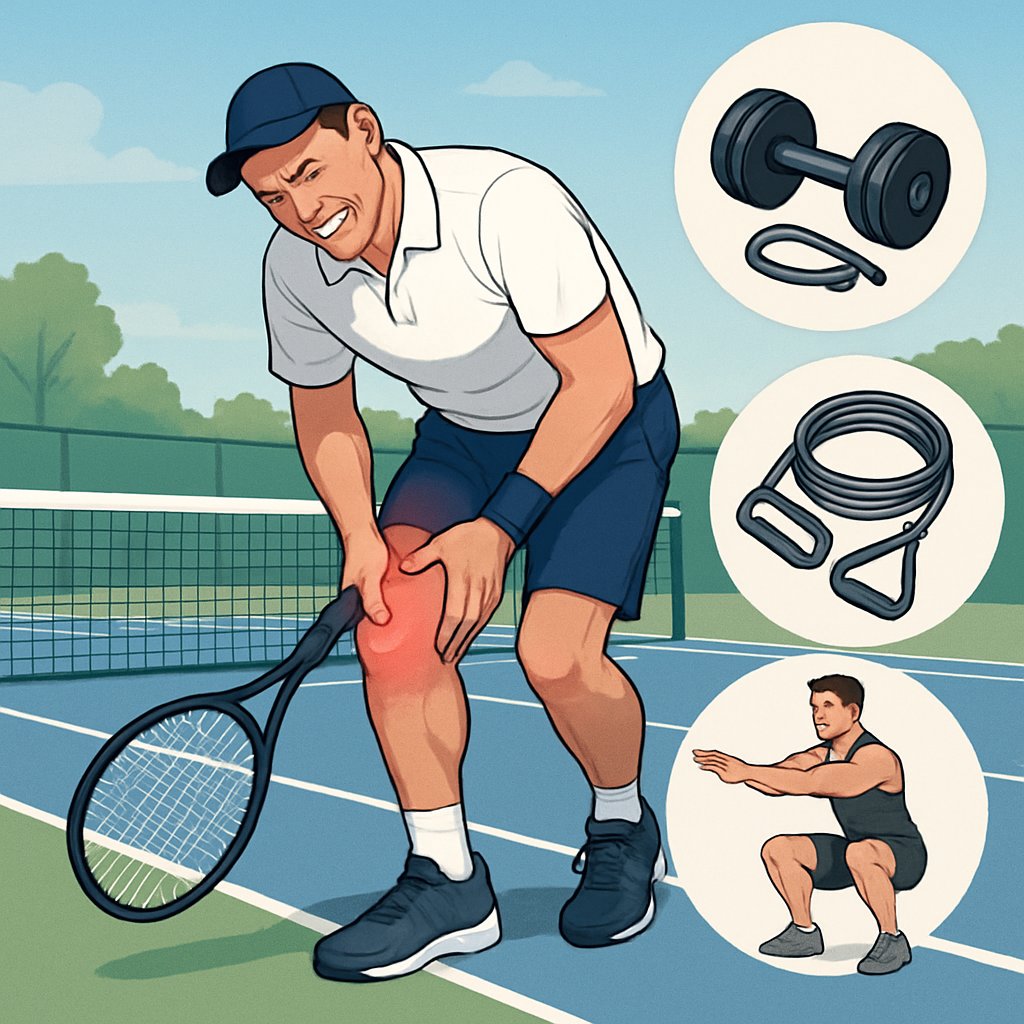
Knee pain is common for tennis players. All those quick cuts and jumps stress out the joints.
Strength training protects your knees and can cut down on pain. Strong muscles around the knee act as built-in shock absorbers.
Three-Stage Training Approach
Proper knee strengthening follows a pattern:
This tennis fitness training guide outlines the importance of building strength around the knee to combat injury and enhance performance.
| Stage | Exercise Type | Purpose |
|---|---|---|
| 1 | Isometric | Build initial strength |
| 2 | Isotonic | Increase load and motion |
| 3 | Plyometric | Restore explosive power |
Start with isometric exercises like wall sits. They build strength without overloading your tendons.
Move on to isotonic exercises. Squats and lunges work your muscles through their full range.
Finish with plyometric moves. Jump squats and lateral hops bring back the explosiveness tennis needs.
Building Balance and Stability
Balance training matters just as much as strength. Try single-leg stands or stability ball work to improve knee control.
Strong glutes and hamstrings support your knees. Don’t skip exercises for these muscle groups—quadriceps alone won’t cut it.
Prevention Through Consistency
Regular strength training keeps knee pain from making a comeback. Make it a habit, not just a quick fix.
Start slow and ramp up gradually. Give your knees time to keep up with new demands.
Always warm up before you play and stretch after. Pair that with strength work for the best shot at staying injury-free.
Strong legs and solid balance let you play pain-free—maybe even longer than you think possible.
Tennis After 40: Train Smarter, Not Harder
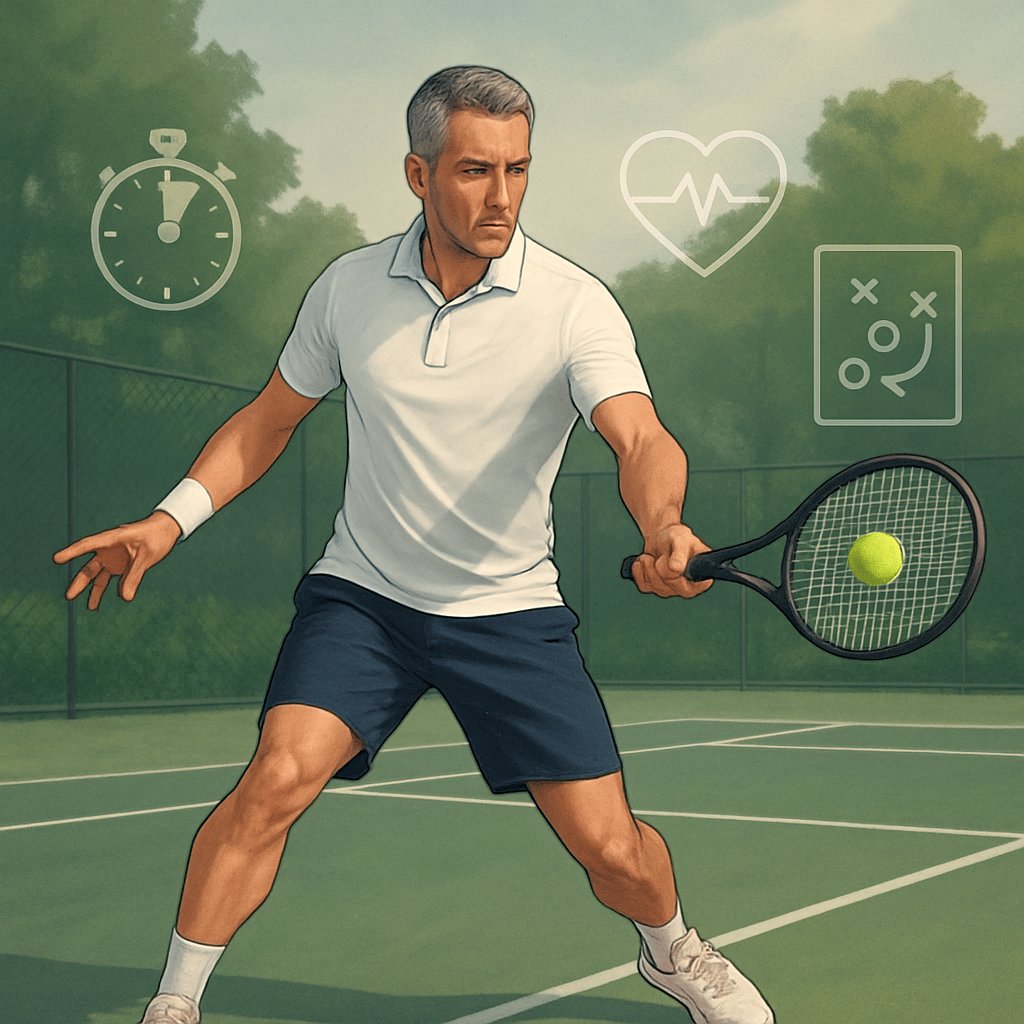
Playing tennis after 40 is a whole different ball game. Your body changes, but you can still play strong with smart training.
Focus on Quality Over Quantity
Short, focused workouts often beat long, draining sessions. As you get older, your body just needs more recovery time.
Implement the tips from this tennis fitness training guide to ensure your training schedule is effective and efficient.
High-intensity interval training can slow down the natural decline in aerobic capacity that comes with age.
Key Training Areas for Players Over 40:
- Mobility and flexibility – Keep joints moving easily
- Balance and stability – Stay upright and move better on court
- Functional strength – Build real-world power for tennis
- Injury prevention – Protect your shoulders, knees, and other weak spots
Smart Training Schedule
Strength training outlined in this tennis fitness training guide is crucial for maintaining your competitive edge.
| Training Type | Frequency | Duration |
|---|---|---|
| Strength training | 2-3 times per week | 30-45 minutes |
| Flexibility work | Daily | 10-15 minutes |
| Tennis play | 2-4 times per week | 60-90 minutes |
Get Fit to Play Tennis
Get fit to play tennis, not the other way around. This mindset can help you avoid injuries and stay competitive.
Age-Appropriate Training Benefits
A good tennis conditioning program for seniors slows muscle loss, boosts strength, helps bones, and keeps weight in check.
Pay attention to your body and adjust intensity as needed. Recovery is more important than ever, so don’t skip rest days.
Utilizing the strategies within this tennis fitness training guide can help you manage your recovery and avoid overtraining.
Youth Tennis Conditioning: Building Athletic Foundation

Young tennis players need the right conditioning to develop their skills safely. Tennis conditioning for kids should focus on fun workouts that build fitness and teach technique.
Key Physical Skills for Youth Players:
- Speed and agility
- Hand-eye coordination
- Basic strength
- Flexibility
- Balance
Tennis brings together a bunch of different abilities. Players need strength, power, speed, coordination, agility, flexibility, and endurance to really perform on court.
This tennis fitness training guide emphasizes the need for youth players to develop their skills safely and effectively.
Age-Appropriate Training Guidelines:
| Age Group | Focus Areas | Training Time |
|---|---|---|
| 6-8 years | Fun movement, basic skills | 15-20 minutes |
| 9-12 years | Coordination, light conditioning | 20-30 minutes |
| 13-16 years | Sport-specific fitness | 30-45 minutes |
Start with basic movement patterns. Add tennis-specific drills once the basics feel natural.
Focus on the elements in this tennis fitness training guide to create engaging and effective training sessions for young players.
Kids learn best through games and activities that feel more like play than exercise. If they’re having fun, they’re learning.
Essential Conditioning Elements:
- Dynamic warm-ups to prep for movement
- Agility ladders to sharpen footwork
- Medicine ball exercises for core strength
- Reaction time drills with colored cones
Keep sessions short and engaging. Structured tennis training programs help kids build good movement habits early on.
Safety Considerations:
Focus on proper form, not intensity. If young athletes feel pain or fatigue that messes with their technique, it’s time to stop.
Recovery time matters for growing bodies. Give them at least one full rest day between tough training sessions.
Tennis fitness for kids takes careful planning to avoid injuries and build a solid athletic base.
Make conditioning enjoyable with games and little challenges. When kids have fun, they stay motivated and stick with tennis longer.
This tennis fitness training guide stresses the importance of making conditioning enjoyable for young athletes.
Post-Match Recovery: Get Back on Court Faster
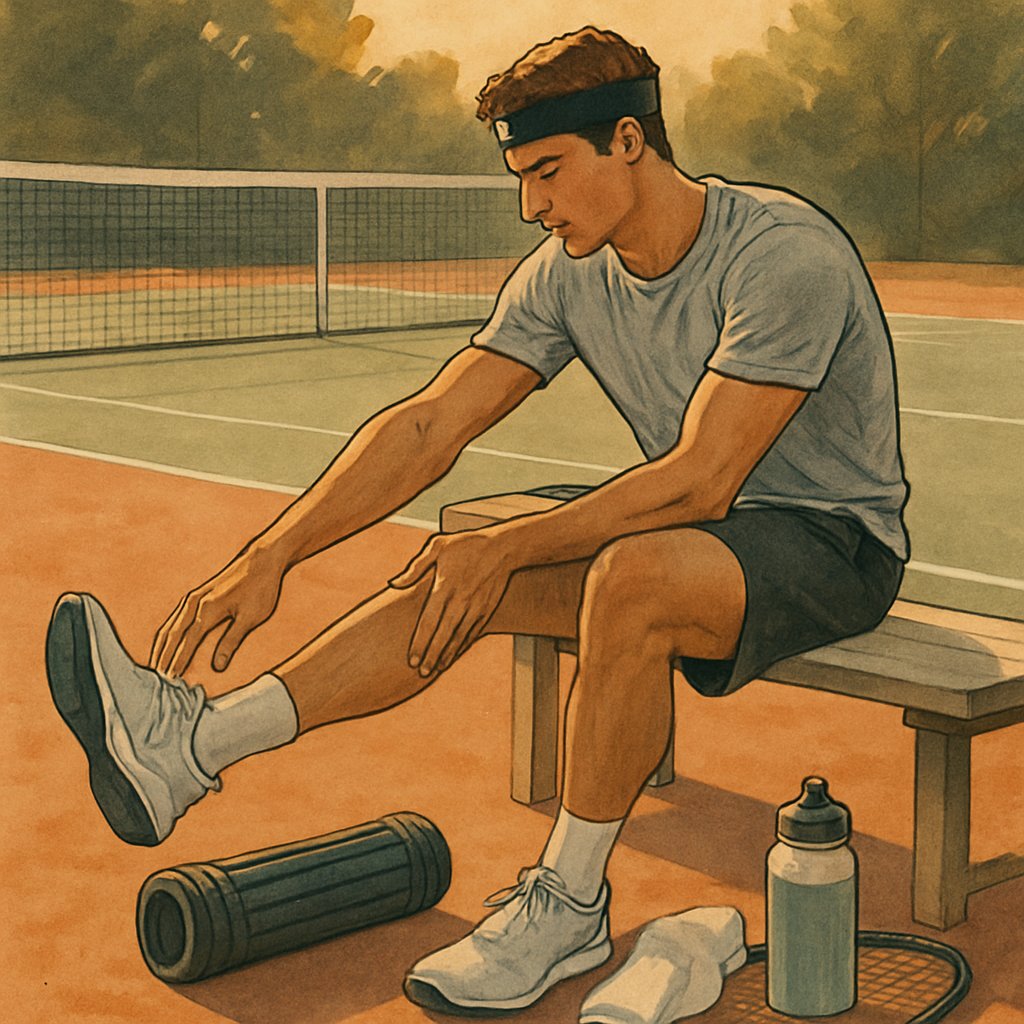
Your body needs solid recovery after every tennis match if you want to keep playing your best. The right recovery techniques help your muscles repair and reduce soreness.
Start recovery right away after your match ends. Those first 30 minutes really set the stage for faster healing.
To enhance recovery, follow the advice from this tennis fitness training guide for optimal post-match strategies.
Essential Recovery Steps
Hydration comes first. Drink water or a sports drink to replace what you lost sweating out there.
Your body needs fluids to kick off the repair process. Don’t skip this step.
Cool down gradually instead of just stopping. Walk around the court for 5-10 minutes to help your heart rate come down.
Stretch your major muscle groups while you’re still warm. Focus on legs, shoulders, and back. Hold each stretch for 20-30 seconds—don’t rush it.
Recovery Tools That Work
| Tool | Benefit | Time Needed |
|---|---|---|
| Foam roller | Reduces muscle tension | 10-15 minutes |
| Ice bath | Decreases inflammation | 10-12 minutes |
| Compression clothes | Improves blood flow | Wear for 2-4 hours |
Tennis recovery stretches help prevent stiffness. Staying loose makes your next match feel way better.
Nutrition matters too. Eat protein and carbs within two hours after finishing. This helps your muscles rebuild and refuels your energy.
Sleep quality really affects how well you recover. Aim for 7-9 hours of sleep after matches—your body does most of its repair work while you’re out cold.
Post-match recovery techniques can speed up muscle repair and get you ready for your next game faster.
For peak performance, utilize the nutrition strategies outlined in this tennis fitness training guide.
Track your recovery by checking in on how you feel each day. Still sore after 48 hours? You probably need more rest or a different recovery plan.
Pro players use these same recovery tricks to stay healthy during long tournaments. You can use them too, whether you play once a week or every day.
Fueling Your Tennis Game: Nutrition for Peak Performance
Nourishing your body with the right foods is a key aspect of the tennis fitness training guide.

The food you eat has a direct impact on your game. Proper tennis nutrition gives you the energy and nutrients you need to play your best.
Pre-Match Fuel
Eat a balanced meal 3-4 hours before playing. Go for complex carbs like pasta, rice, or oatmeal and add some lean protein—think chicken or fish.
Avoid heavy, greasy meals. Spicy or unfamiliar foods on match day? Not a great idea.
During Match Energy
If your match goes longer than 90 minutes, take in 30-60 grams of carbs per hour. Some good options:
- Bananas
- Sports drinks
- Energy bars
- Dried fruit
Recovery Nutrition
Within 30 minutes after playing, eat protein and carbs together. This helps repair muscles and top up your energy stores.
Chocolate milk, a turkey sandwich, or Greek yogurt with fruit all work well.
Essential Nutrients
| Nutrient | Purpose | Food Sources |
|---|---|---|
| Carbohydrates | Primary energy source | Pasta, rice, fruits |
| Protein | Muscle repair | Chicken, fish, eggs |
| Healthy Fats | Long-term energy | Nuts, avocados, olive oil |
Hydration Basics
Start hydrating a few hours before you play. Drink 16-20 ounces of water 2-3 hours before matches.
During play, aim for 6-8 ounces every 15-20 minutes. Sports drinks can help replace electrolytes if your match is a long one.
Check your urine color—pale yellow means you’re in good shape.
Timing Matters
Tennis nutrition planning around matches keeps your energy steady. If you need extra fuel, grab a small snack 1-2 hours before playing.
Listen to your body and experiment during practice. Everyone’s a little different, so find what works for you.
This tennis fitness training guide will help you develop a personalized nutrition strategy for peak performance.
Mental Toughness Training: Physical Prep for Psychological Edge
By integrating physical preparation techniques from this tennis fitness training guide, you can gain a psychological edge on the court.
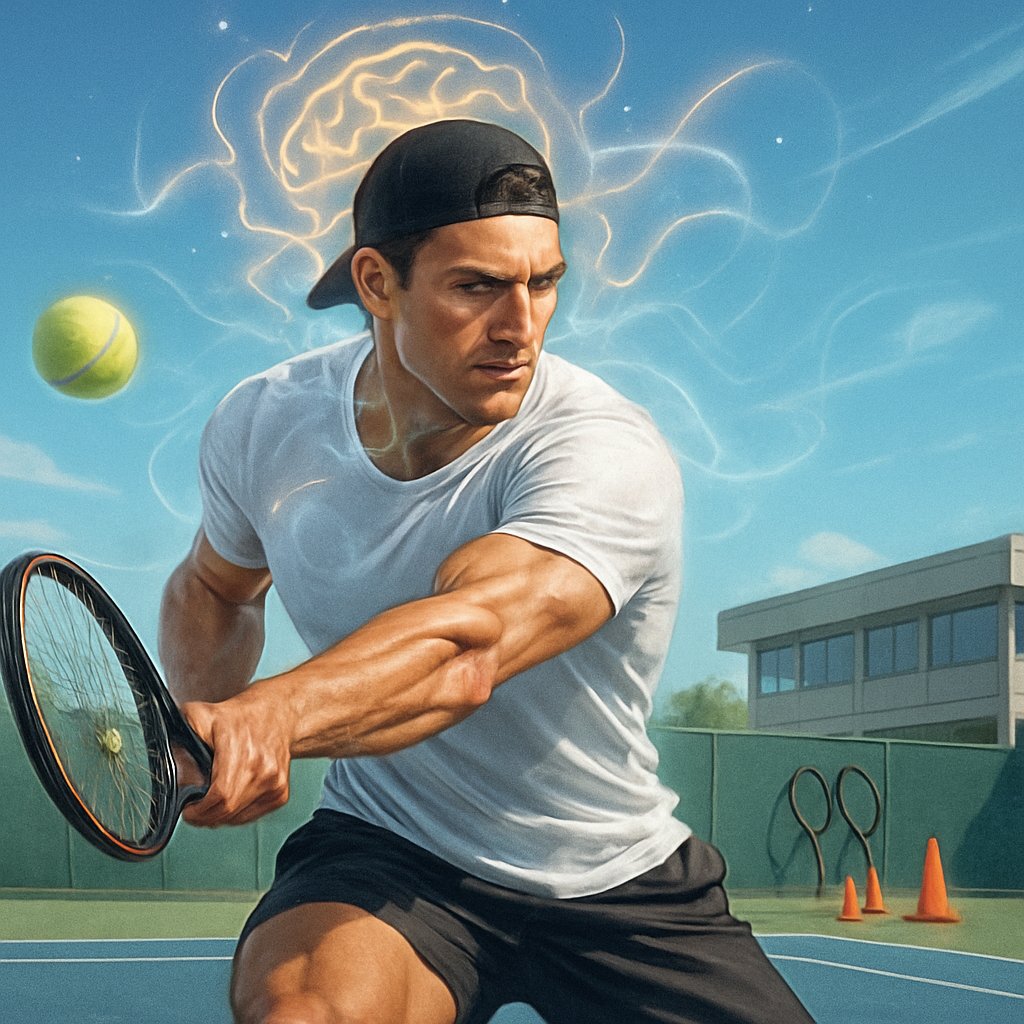
Your physical training shapes your mental game on the court. Tennis demands mastery of technique, physique, tactics, and the mind.
Building Mental Strength Through Physical Work
Intense physical training lays the groundwork for mental toughness. When your body can handle long matches, your mind stays sharp at the big moments.
Physical fatigue can tank your concentration. If you’re well-conditioned, you can focus longer and make better decisions.
Key Physical Elements for Mental Performance
| Physical Component | Mental Benefit |
|---|---|
| Cardiovascular fitness | Sustained concentration |
| Strength training | Confidence under pressure |
| Recovery protocols | Better decision-making |
Training Methods That Build Both
Practice drills when you’re tired. It’s not easy, but it teaches your mind to stay locked in when your body wants to quit.
High-intensity interval training mimics match pressure. Your heart rate spikes during key points, so train your body to handle that stress now.
Mental Training During Physical Work
Try breathing exercises during rest periods between sets. It helps you stay calm under pressure, which is huge in matches.
Mindfulness techniques and breathing exercises can really make a difference in your performance.
Practice positive self-talk during tough workouts. If you can stay positive while lifting heavy, you’ll do it during a tight tiebreaker too.
Recovery as Mental Training
Recovery practices highlighted in this tennis fitness training guide can enhance your overall mental resilience.
Your recovery routine also builds mental discipline. Stretching, ice baths, and getting enough sleep all take commitment.
Those habits build the mental toughness you need for consistent results on court.
Frequently Asked Questions
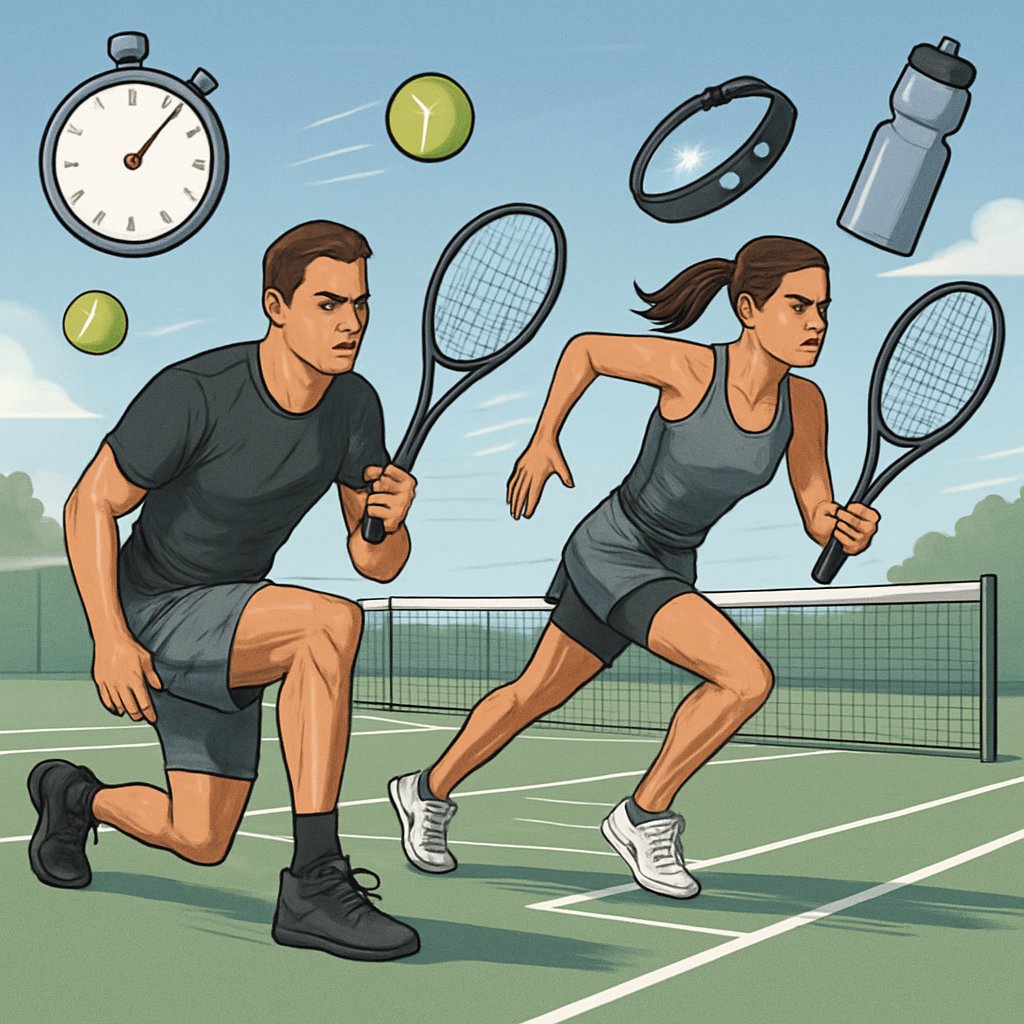
Tennis players need training that targets the sport’s unique demands. Here are answers to common questions about workouts, strength routines, and training methods to boost your court performance.
What are the essential workouts for tennis fitness improvement?
Tennis fitness needs a well-rounded approach: cardio, strength, agility drills, and flexibility. Your training should build endurance for long rallies and explosive power for quick moves.
Cardio exercises like running, cycling, and interval training boost your stamina. High-intensity intervals work especially well because they match tennis’s stop-and-start rhythm.
Plyometric exercises develop the explosive power you need for serves and volleys. Box jumps, lateral bounds, and medicine ball throws fire up those fast-twitch muscles.
Core strengthening exercises improve stability and rotation. Planks, Russian twists, and dead bugs lay the groundwork for powerful groundstrokes.
How do I develop a strength and conditioning routine for tennis?
You’ll want to strength train two or three times a week for best results. Change up the intensity depending on your match schedule so you can actually recover.
Stick to compound moves that hit several muscle groups at once. Squats, deadlifts, and lunges are great for powering up your legs and boosting your movement on court.
Pull-ups and rows? Those help your back muscles, which you’ll need for big serves and overheads. Don’t skip them.
Mix in pushing and pulling exercises for your upper body. Push-ups, shoulder presses, and chest presses help balance out all those pulling tennis motions.
Try to lift on days you’re not playing matches. Heavy lifting right before a match isn’t the best idea—it can leave you sluggish or even raise your risk of injury.
What off-court exercises can benefit my on-court tennis performance?
Swimming’s a solid pick for cardio and it’s gentle on your joints. The water’s resistance also works your core and shoulders, which is handy.
Yoga can make you more flexible and balanced, plus it helps ease muscle tension. Honestly, a little yoga goes a long way in dodging those nagging tennis injuries like shoulder or back issues.
Cycling’s another option for building leg strength and endurance, minus the pounding from running. If you crank up the intervals on a stationary bike, you can even mimic the stop-and-go of tennis rallies.
Resistance bands are underrated. Use them for tennis-like movements—rotations, quick accelerations. They let you train the exact motions you’ll use in a match.
What specific agility drills enhance movement for tennis players?
Ladder drills are classic for foot speed and coordination. Try in-in-out-out steps or lateral shuffles—your feet will get quicker, promise.
Cone drills help with changing directions fast. Set up a few cones, move between them, and focus on nailing your footwork.
Shadow swings are weirdly effective. Move around the court and practice your strokes without a ball—it’s all about syncing movement with your swing.
Want to react faster? Use colored cones or call out commands during drills. Quick reactions can make the difference when you’re reaching for a tough shot.
How can a strength and conditioning coach improve my tennis game?
A good coach looks at your unique needs and builds a program just for you. They’ll check your movement patterns and pick exercises that fix any weak spots.
A coach can help you implement the strategies found in this tennis fitness training guide to maximize your training effectiveness.
Coaches also make sure you’re doing exercises right so you don’t get hurt. Bad form in training can mess up your game more than you’d think.
They’ll plan your workouts so you peak at the right time for tournaments. Basically, they adjust things as your competition schedule changes.
Having a coach keeps you on track. They’ll watch your progress and tweak your plan as you get stronger or fitter—keeps things moving forward.
What are the physical benefits of incorporating tennis into my fitness regime?
Understanding the physical benefits of tennis is crucial, and our tennis fitness training guide covers that extensively.
Tennis gets your heart pumping with constant movement and quick rallies. You can burn anywhere from 400 to 600 calories an hour, depending on how hard you play.
It also sharpens hand-eye coordination and speeds up your reaction time. Those skills come in handy for other sports—and just navigating daily life, honestly.
Running and jumping on the court builds bone density. That extra impact can help keep osteoporosis at bay as you get older.
Playing tennis regularly boosts your balance and agility. All those quick changes in direction work your stabilizing muscles in ways you might not expect.
